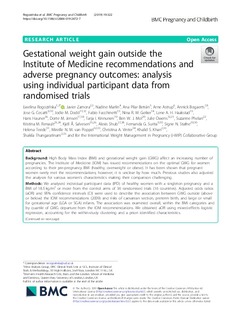| dc.contributor.author | Rogozińska, Ewelina | |
| dc.contributor.author | Zamora, Javier | |
| dc.contributor.author | Marlin, Nadine | |
| dc.contributor.author | Betran, Ana Pilar | |
| dc.contributor.author | Astrup, Arne | |
| dc.contributor.author | Bogaerts, Annick | |
| dc.contributor.author | Cecatti, José Guilherme | |
| dc.contributor.author | Dodd, Jodie M. | |
| dc.contributor.author | Facchinetti, Fabio | |
| dc.contributor.author | Geiker, Nina Rica Wium | |
| dc.contributor.author | Haakstad, Lene Annette Hagen | |
| dc.contributor.author | Hauner, Hans | |
| dc.contributor.author | Jensen, Dorte M. | |
| dc.contributor.author | Kinnunen, Tarja I. | |
| dc.contributor.author | Mol, Ben Willem J. | |
| dc.contributor.author | Owens, Julie | |
| dc.contributor.author | Phelan, Suzanne | |
| dc.contributor.author | Renault, Kristina | |
| dc.contributor.author | Salvesen, Kjell Å | |
| dc.contributor.author | Shub, Alexis | |
| dc.contributor.author | Surita, Fernanda | |
| dc.contributor.author | Stafne, Signe Nilssen | |
| dc.contributor.author | Teede, Helena | |
| dc.contributor.author | van Poppel, Mireille N.M. | |
| dc.contributor.author | Vinter, Christina Anne | |
| dc.contributor.author | Khan, Khalid S. | |
| dc.contributor.author | Thangaratinam, Shakila | |
| dc.date.accessioned | 2020-02-20T09:52:56Z | |
| dc.date.available | 2020-02-20T09:52:56Z | |
| dc.date.created | 2020-01-13T11:28:32Z | |
| dc.date.issued | 2019 | |
| dc.identifier.citation | BMC Pregnancy and Childbirth. 2019, 19 . | nb_NO |
| dc.identifier.issn | 1471-2393 | |
| dc.identifier.uri | http://hdl.handle.net/11250/2642817 | |
| dc.description.abstract | Background:High Body Mass Index (BMI) and gestational weight gain (GWG) affect an increasing number ofpregnancies. The Institute of Medicine (IOM) has issued recommendations on the optimal GWG for womenaccording to their pre-pregnancy BMI (healthy, overweight or obese). It has been shown that pregnantwomen rarely met the recommendations; however, it is unclear by how much. Previous studies also adjustedthe analyses for various women’s characteristics making their comparison challenging.Methods:We analysed individual participant data (IPD) of healthy women with a singleton pregnancy and aBMI of 18.5 kg/m2or more from the control arms of 36 randomised trials (16 countries). Adjusted odds ratios(aOR) and 95% confidence intervals (CI) were used to describe the association between GWG outside (aboveor below) the IOM recommendations (2009) and risks of caesarean section, preterm birth, and large or smallfor gestational age (LGA or SGA) infants. The association was examined overall, within the BMI categories andby quartile of GWG departure from the IOM recommendations. We obtained aOR using mixed-effects logisticregression, accounting for the within-study clustering and a priori identified characteristics. Results:Out of 4429 women (from 33 trials) meeting the inclusion criteria, two thirds gained weight outsidethe IOM recommendations (1646 above; 1291 below). The median GWG outside the IOM recommendationswas 3.1 kg above and 2.7 kg below. In comparison to GWG within the IOM recommendations, GWG abovewas associated with increased odds of caesarean section (aOR 1.50; 95%CI 1.25, 1.80), LGA (2.00; 1.58, 2.54),and reduced odds of SGA (0.66; 0.50, 0.87); no significant effect on preterm birth was detected. Therelationship between GWG below the IOM recommendation and caesarean section or LGA was inconclusive;however, the odds of preterm birth (1.94; 1.31, 2.28) and SGA (1.52; 1.18, 1.96) were increased.Conclusions:Consistently with previous findings, adherence tothe IOM recommendations seem to help achieve betterpregnancy outcomes. Nevertheless, even in the context of clinical trials, women find it difficult to adhere to them. Furtherresearch should focus on identifying ways of achieving a healthier GWG as defined by the IOM recommendations. | nb_NO |
| dc.language.iso | eng | nb_NO |
| dc.publisher | BMC (part of Springer Nature) | nb_NO |
| dc.rights | Navngivelse 4.0 Internasjonal | * |
| dc.rights.uri | http://creativecommons.org/licenses/by/4.0/deed.no | * |
| dc.title | Gestational weight gain outside the Institute of Medicine recommendations and adverse pregnancy outcomes: analysis using individual participant data from randomised trials | nb_NO |
| dc.type | Journal article | nb_NO |
| dc.type | Peer reviewed | nb_NO |
| dc.description.version | publishedVersion | nb_NO |
| dc.source.pagenumber | 12 | nb_NO |
| dc.source.volume | 19 | nb_NO |
| dc.source.journal | BMC Pregnancy and Childbirth | nb_NO |
| dc.identifier.doi | 10.1186/s12884-019-2472-7 | |
| dc.identifier.cristin | 1771255 | |
| dc.description.localcode | © The Author(s). 2019 Open Access This article is distributed under the terms of the Creative Commons Attribution 4.0 International License (http://creativecommons.org/licenses/by/4.0/ | nb_NO |
| cristin.unitcode | 194,65,15,0 | |
| cristin.unitcode | 1920,13,0,0 | |
| cristin.unitcode | 1920,7,0,0 | |
| cristin.unitcode | 194,65,20,0 | |
| cristin.unitname | Institutt for klinisk og molekylær medisin | |
| cristin.unitname | Kvinneklinikken | |
| cristin.unitname | Klinikk for kliniske servicefunksjoner | |
| cristin.unitname | Institutt for samfunnsmedisin og sykepleie | |
| cristin.ispublished | true | |
| cristin.fulltext | original | |
| cristin.qualitycode | 1 | |

